February 17, 2020 feature
Increasing the service life of polymer electrolyte fuel cells with a nanodispersed ionomer
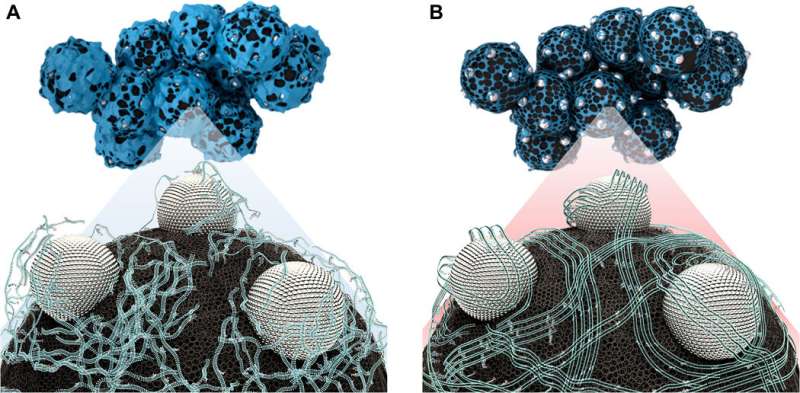
Protons (subatomic particles) can be transferred from the anode to the cathode through the ionomer membrane in polymer electrolyte fuel cells (PEFC). Scientists can extend proton pathways by impregnating the ionomer (type of polymer) into the electrodes to achieve improved proton transfer efficiency. Since the impregnated ionomer can mechanically bind catalysts within the electrode, they are known as a binder. In a new report on Science Advances, Chi-Yeong Ahn and a research team introduced a simple approach to use a supercritical fluid and prepare a homogenous nanoscale dispersion of binder material in aqueous alcohol. The preparation showed high dispersion character, crystallinity and proton conductivity for high performance and durable applications in a PEFC cathode electrode.
Polymer electrolyte fuel cells (PEFCs) are that can efficiently convert chemical energy of the fuel directly into electrical energy. The PEFCs are largely influenced by key components including polymer electrolyte membranes, catalysts and (PFSA) ionomers. Redox reactions that occur in a PEFC mainly occur at the electrode interface known as the (TPB) at which the reactant gases (H2 at the anode and O2 at the cathode) platinum (Pt) catalyst particles, on electron-conducting carbon materials (hence the triple phase). In the present study, Ahn et al. described an ionomer dispersion with an average colloidal particle size much smaller than commercially available dispersions by treating a with aliphatic alcohol under . The , a brand name for a (PFSA) membrane introduced by E. I. du Pont de Nemours and Company in the 1960s, can separate the anode and cathode compartment in and in .
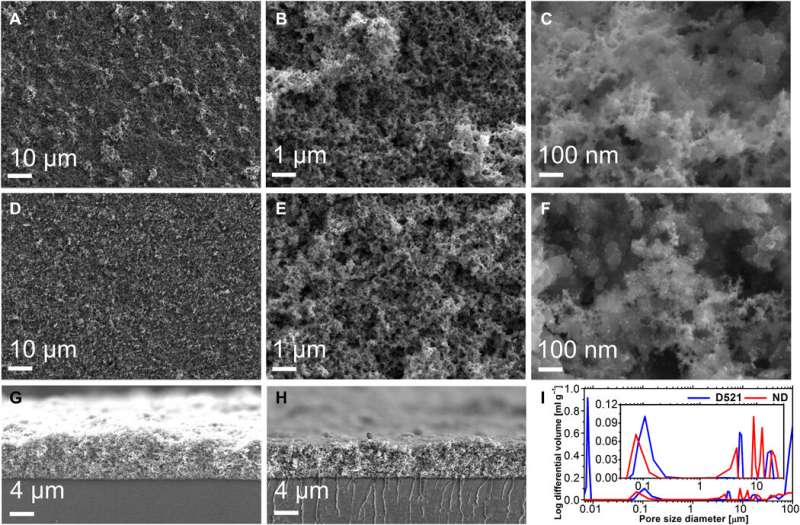
Supercritical fluids (SCFs) are widely used in industry and research to synthesize , and , with additional applications to prepare materials for electrochemical studies. However, researchers remain to explore the efficacy of superacidic perfluorinated sulfonic acid (PFSA) ionomers as electrode binders. To accomplish this, Ahn et al. first obtained laboratory-made ionomer dispersion by treating a commercially available Nafion membrane in an aqueous medium of isopropyl alcohol (IPA) in the supercritical fluid state (SCF). Then using , the researchers observed ionomer particle distributions with sizes smaller than 100 nm and named the laboratory-made dispersion a 'nanodispersion' (ND). The ND underwent a phase transition from an aqueous dispersion to a solid, for its use as a cathode binder. Using they obtained the crystallinities of ND and showed them as semi-crystalline chains packed uniformly with improved regularity, compared to used in other PEFC systems. The improved proton conductivity of the ND implied lower resistance; predicting a high-level of performance of the (MEA) for single-cell operation.
Ahn et al. characterized (tested) the ionomer dispersion made with SCF, using to observe the topography and (MIP) to measure porosities. They observed a relatively uniform surface of the ND on the MEA (membrane-electrode assembly) surface; the ND ionomer was well dispersed on the Pt/C catalyst in the ink slurry to prepare the MEA to begin with. Based on the morphologies and pore size distribution of the catalyst, the ND had better ionomer dispersibility for fuel use within the membrane-electrode assembly.
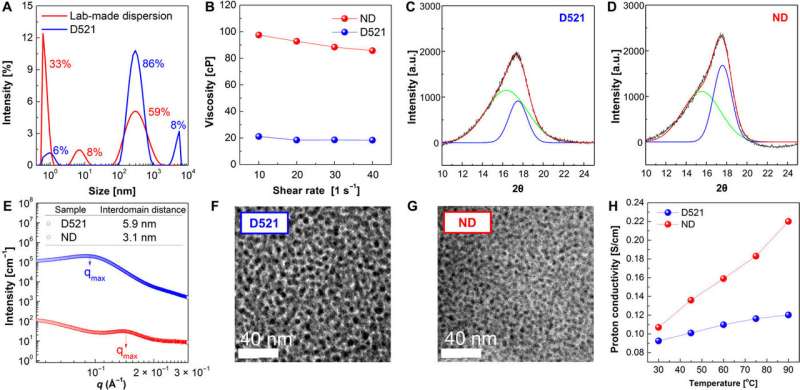
The binder content for electrode formulation was important as one of the components that determined the triple phase boundary (TPB). The scientists tuned the ionomer ratio in the electrodes whenever one of the electrode components were changed. To understand the performance of ionomers, they detected the electrochemical performances of MEAs using cathodes with 30 percent weight of D521 (MEA-0) vs. 10, 20, and 30 percent weight ND (MEA-10, MEA-20 and MEA-30). The MEA performances increased with the ionomer content. They determined an appropriate amount of ionomer for MEA fabrication and decided on MEA-20, which exhibited the highest performance in an atmosphere of oxygen. When they measured electrochemical performance of MEAs in air, the fuel cell performance decreased due to the presence of inert nitrogen and reduced concentrations of oxygen.
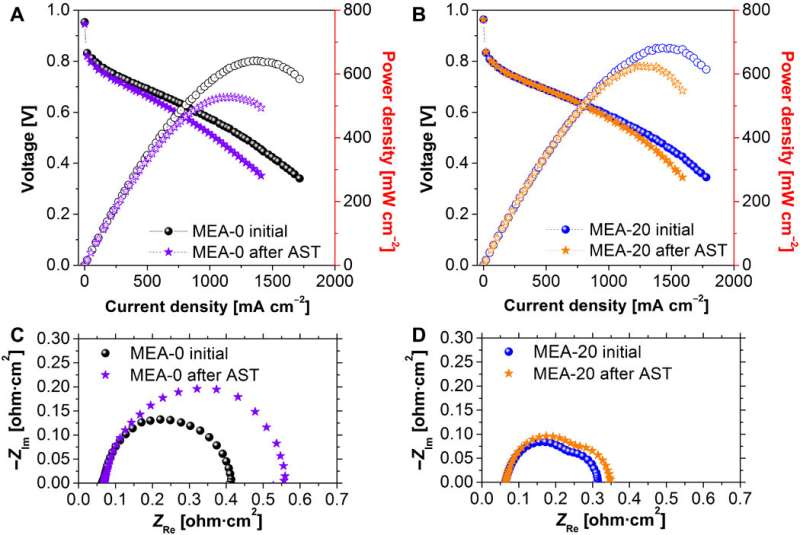
To understand single-cell performance and electrochemical durability, the team selected two samples (MEA-0 and MEA-20) and conducted the (AST). They performed AST using a load-cycling method, which caused severe degradation of the cathode electrode. The degree of electrochemical degradation depended on the type of ionomer used in the cathode. For example, MEA-20 (ND ionomer) maintained its electrochemical performance at 3.33 percent in the presence of oxygen and its electrochemical durability increased about six times more than that of MEA-0, relative to the current density.
Even after the accelerated stress tests (AST), the current density of MEA-20 was higher than the initial current density of MEA-0. The degradation of catalyst was therefore serious in MEA-0 but barely noticeable in MEA-20. Ahn et al. credited the high molecular weight and improved crystallinity of the constituent ionomer to justify the improved electrochemical tolerance of the ND electrode, which helped prevent catalyst degradation. They performed (TEM) to confirm physical changes in the electrode after AST and noted less catalyst degradation in the ND electrode. The extremely enhanced electrochemical durability was due to improved mechanical strength based on the high molecular weight and improved crystalline character of the ND, which was more difficult to be washed away during PEFC function.
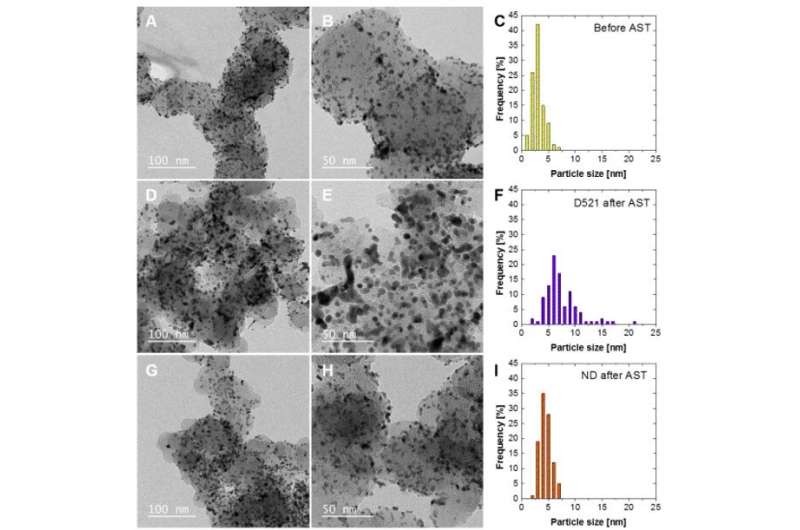
In this way, Chi-Yeong Ahn and colleagues demonstrated the preparation and characterization of ND ionomer containing an average particle size smaller than D521 ionomer (which had an identical chemical architecture and equivalent weight). They confirmed the electrochemical efficacy of ND as a cathode binder material and observed unique morphologies for ND ionomer obtained from the SCF (Supercritical fluid) process. These morphologies corresponded to improved proton conductivity and single cell performances—resulting from an effective proton transport pathway. The higher crystalline content and molecular weight of ND improved the mechanical strength and enhanced the MEA lifetime by a factor of six at a current density of 0.6 V. The results showed improved performance and durability of PEFC electrodes. The research team expect the electrode to further improve performance and durability upon applying the newly formed ionomer with a high-performance catalyst within a polymer electrolyte fuel cell.
More information: Chi-Yeong Ahn et al. Enhancement of service life of polymer electrolyte fuel cells through application of nanodispersed ionomer, Science Advances (2020).
Zhi Wei Seh et al. Combining theory and experiment in electrocatalysis: Insights into materials design, Science (2017).
B. C.-Y. Lu et al. Solubility enhancement in supercritical solvents, Pure and Applied Chemistry (2007).
Journal information: Science Advances , Science
© 2020 Science X Network





















